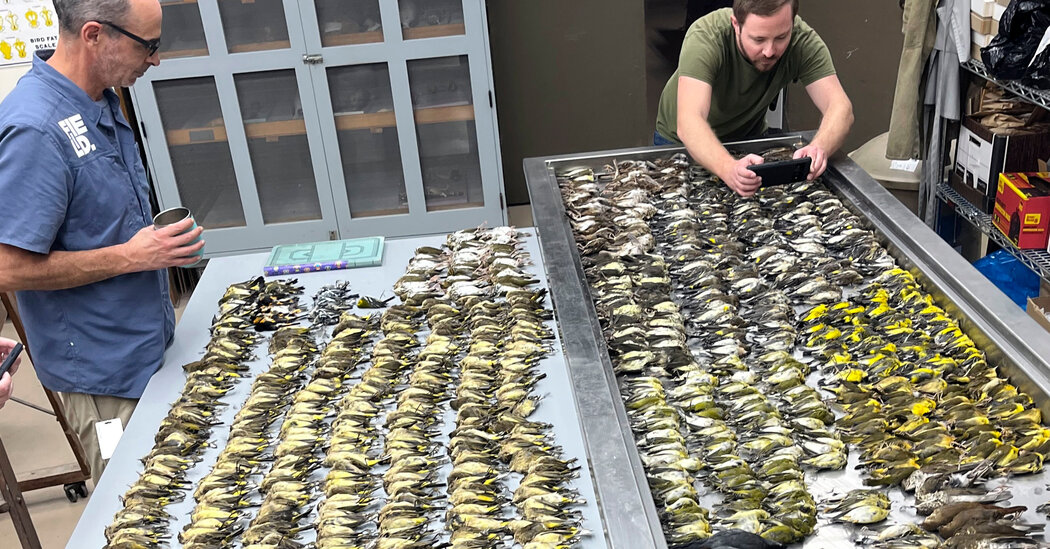Millions of birds fly over Chicago during the fall migration season, and a number of them die after being confused by bright lights or after trying to fly through a window, but the carpet of bird carcasses outside a convention center on Thursday morning shocked people who have been monitoring birds in the city for decades.
At least 961 dead birds were found outside the McCormick Place Lakeside Center, according to the Field Museum, a natural history museum about one mile north of the convention center.
Volunteers and scientists at the museum go to the convention center, which overlooks Lake Michigan and has an exterior made mainly of glass, each day during the spring and fall migration seasons to search for birds that have clattered into the building overnight. The building, which has four levels, is not especially tall compared with nearby skyscrapers.
Douglas Stotz, a senior conservation ecologist at the museum, said that he was “blown away” by how many birds were migrating on Wednesday night and early on Thursday, as well as by how many were found dead.
“I’ve been in Chicago for 40 years and bird-watch all the time and I’ve never, ever seen anything like that,” he said on Sunday.
Mr. Stotz said that the number of birds that strike the convention center each day varies.
The previous record had been around 200 dead birds. Some days, no birds die. The nearly 1,000 dead birds found on Thursday were the most the museum had recorded in the four decades that it has been keeping track, he said.
Mr. Stotz said that a large number of birds were migrating that night because their travel had been delayed by unfavorable weather conditions. Before Wednesday night, the temperature had been unusually high and the birds encountered a headwind.
When the temperatures dropped and the wind shifted, a huge number of birds took advantage of the improved conditions and flew over Chicago, which is in Cook County.
Around 3:40 a.m. on Thursday, about 1.49 million birds were in flight above Cook County, according to BirdCast, a bird migration tracking project by the Cornell Lab of Ornithology, Colorado State University and the University of Massachusetts Amherst.
Around this time, a small storm system moved through the city.
“The birds hit this storm and they drop out, they don’t want to fly through the storm,” Mr. Stotz said. “So they come down to the ground, and that sets up the conditions for the incredible migration we saw — and for the big kill we saw.”
Birds are confused by lights and windows, which they don’t know they can’t fly through.
It is a problem in all cities. Between 365 million and 988 million birds are killed annually by striking buildings in the United States, according to a 2014 study by the Smithsonian Conservation Biology Institute and the U.S. Fish and Wildlife Service.
At the Field Museum, dead birds are turned over to a flesh-eating beetle colony that cleans the birds so that their skeletal remains can be added to the museum’s collection and used for research.
Mr. Stotz said that the high concentration of dead birds found on Thursday should emphasize how important it is for buildings to turn off their lights during bird migration season. He also hopes it will move building owners to opt for windows that are less reflective or more opaque, which are safer for birds.
In a statement, McCormick Place said that it was “truly saddened by this incident” and described its efforts to reduce bird window strikes, including participating in Lights Out Chicago, a program managed by the Chicago Audubon Society that encourages building owners to turn off or dim decorative lights.
The statement said that lights at the complex are turned off unless they are needed for workers and visitors. There had been an event during the week of the bird strikes, so the lights were sometimes on, the statement said.
“We deeply appreciate our community’s concern for the welfare of birds and your engagement with our efforts to mitigate these issues, and we are in discussion with industry experts to look for better solutions to protect our avian neighbors,” the statement said.
A large number of dead birds were also found on Thursday in other parts of downtown Chicago, said Annette Prince, director of Chicago Bird Collision Monitors.
Ms. Prince told WGN Radio that the group on Thursday found about 300 injured birds and about 700 to 800 dead birds in the square mile it monitored.
Outside some buildings, the group found more than 100 dead or injured birds, which she said “was a very unusual and tragic occurrence.”











